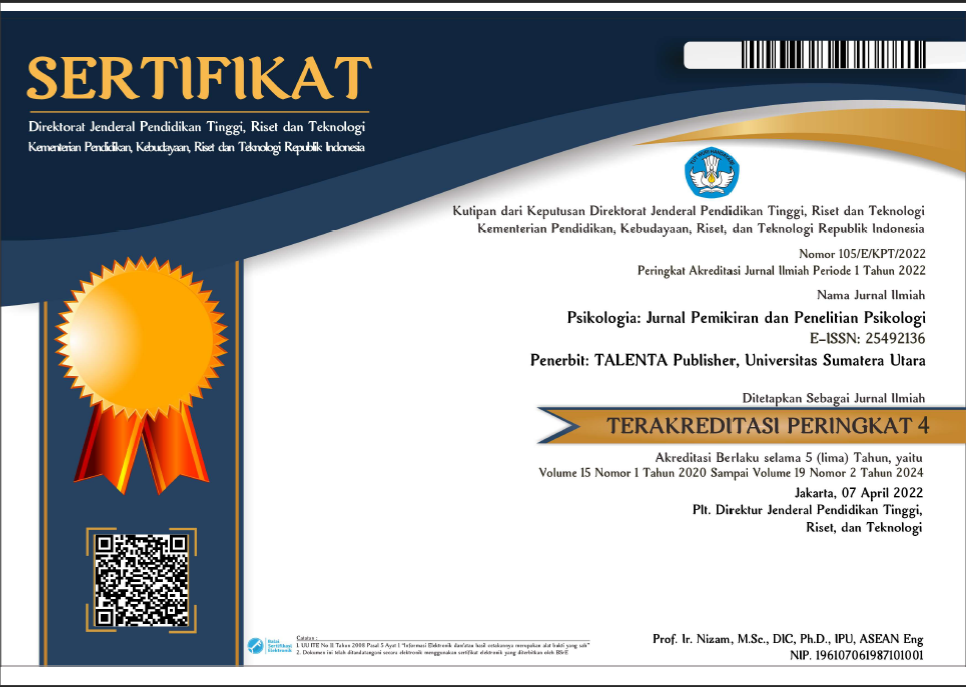Depression among inmates who are sentenced to death or life imprisonment
Gambaran depresi pada narapidana yang divonis hukuman mati atau hukuman seumur hidup
DOI:
https://doi.org/10.32734/psikologia.v15i2.4480Keywords:
depression, adult inmate, prison, death sentence, life sentenceAbstract
The present study explores depression among inmates sentenced to death or life imprisonment. This study uses a descriptive quantitative method conducted by giving out an adapted version of the Beck Depression Inventory-II scale to the inmates. The results showed that about 21 percent of the inmates had a mild mood disorder, 5 percent had mild depression, 32 percent had moderate depression, and 42 percent had severe depression. For those who have received a life sentence, about 15 percent had a mild mood disorder, 20 percent mild depression, 27 percent had moderate depression, and 37 percent had severe depression. Overall, the inmates sentenced to the death penalty and life imprisonment had high levels of depression.
Penelitian ini mengeksplorasi depresi di antara narapidana yang dijatuhi hukuman mati atau penjara seumur hidup. Penelitian ini menggunakan metode deskriptif kuantitatif yang dilakukan dengan memberikan versi Beck Depression Inventory-II scale yang diadaptasi kepada narapidana. Hasil penelitian menunjukkan, sekitar 21 persen narapidana mengalami gangguan mood ringan, 5 persen mengalami depresi ringan, 32 persen mengalami depresi sedang, dan 42 persen mengalami depresi berat. Bagi mereka yang mendapat hukuman seumur hidup, sekitar 15 persen mengalami gangguan mood ringan, 20 persen depresi ringan, 27 persen mengalami depresi sedang, dan 37 persen mengalami depresi berat. Secara keseluruhan, narapidana yang dijatuhi hukuman mati dan seumur hidup memiliki tingkat depresi yang tinggi.
Downloads
References
Ahmad, A. (2014). Stress and depression: A comparison study between men and women inmates in Peninsular Malaysia. 4, 153–160.
Amir Hasan Ramli, W. U. (2012). Urgensi penyusunan model bimbingan kesehatan mental (mental hygiene) selama menunggu eksekusi mati. Journal de Jure, 4, 34–48. https://doi.org/10.18860/j-f sh.v4i1.2157
Beck, A. T., Ward, C. H., Mendelson, M., Mock, J., dan Erbaugh, J. (1961). An inventory for measuring depression. Arch Gen Psychiatry, 4, 561–571. https://doi.org/doi:10.1001/archpsyc.196
01710120031004
Degenova, M. K. (2008). Intimate relationships, marriages, dan families (7th Ed.). New York, NY: McGraw-Hill.
Edgar, K., dan Rickford, D. (2009). Neglecting the mental health of prisoners. International Journal of Prisoner Health, 5, 166–170. https://doi.org/10.1080/17449200903115839
Ginn, S. (2012). Dealing with a mental disorder in prisoners. BMJ (Online), 345(7885). https: //doi.org/10.1136/bmj.e7280
Grounds, A. (2004). Psychological consequences of wrongful conviction and imprisonment. Canadian
Journal of Criminology and Criminal Justice, 46, 165–182. https://doi.org/10.3138/cjccj.46.2.165
Inaba, A., Thoits, P. A., Ueno, K., Gove, W. R., Evenson, R. J., dan Sloan, M. (2005). Depression in the United States and Japan: gender, marital status, and SES patterns. Social Science and Medicine,
, 2280–2292. https://doi.org/10.1016/j.socscimed.2005.07.014
Indonesia, P. (2002). Undang-Undang Republik Indonesia Nomor 22 Tahun 2002.
Kamea, H. C. (2013). Pidana penjara seumur hidup dalam sistem hukum pidana di Indonesia. Lex Crimen, II(2), 43–55.
Kamilah, S., Eddyono, W., dan Gandini, Erasmus A T Napitupulu, A. (2015). Hukuman mati dalam R KUHP: jalan tengah yang meragukan.
Khan, T. M., Hussain, H., Khan, G., Khan, A., Badshah, A., dan Sarwar, R. (2012). Incidence of depression among incarcerated women in central prison, Peshawar, Pakistan. European Journal of General Medicine, 9, 33–38. https://doi.org/10.29333/ejgm/82552
Kumar, V., dan Daria, U. (2013). Psychiatric morbidity in prisoners. Indian Journal of Psychiatry, 55, 366–370. https://doi.org/10.4103/0019-5545.120562
Lubis, N. L. (2012). Depresi Tinjauan Psikologis. Jakarta: Kencana Prenada Media.
Nwaopara, U., dan Stanley, P. (2015). Prevalence of Depression in Port Harcourt Prison. Journal of
Psychiatry, 18, 1–8. https://doi.org/10.4172/2378-5756.1000340
Santrock, J. W. (2015). Life-span development (15th ed.). New York: McGraw-Hill Education.
Sarafino, E. P., dan Smith, T. W. (2011). Health psychology (Seventh Ed). United States of America:
John Wiley dan Sons, Inc.
Shinkfield, A. J., Graffam, J., dan Meneilly, S. (2009). Co-morbidity of conditions among prisoners. Journal of Offender Rehabilitation, 48, 350–365. https://doi.org/10.1080/10509670902851125
Tanti, R. (2007). Stres dan kehidupan penghuni Lembaga Permasyarakatan. Jurnal Ilmiah Kebijakan Hukum, 1, 73–85.
Vaeroy, H. (2011). Depression, anxiety, and history of substance abuse among Norwegian inmates in preventive detention: reasons to worry? BMC Psychiatry, 11, 40. https://doi.org/10.1186/1471-2 44X-11-40
Wilkinson, G. (1995). Depresi (terjemahan oleh Meitasari Tjandrasa). Jakarta: Penerbit Arcan.
Wilson, R. J. (2016). The death penalty and mental illness in international human rights law: toward abolition. Washington dan Lee Law Review, 73, 1469–1499.
World Health Organisation. (2007). Trencin statement on prisons and mental health. Retrieved from http://www.euro.who.int/%20data/assets/pdf%7B%5C_%7Dfile/0006/99006/E91402.pdf
Zikri, A. (2012). Gambaran kesehatan mental narapidana di Lembaga Permasyarakatan Klas IIA Banda Aceh. Electronic Theses and Dissertations Unsyiah.
Downloads
Published
How to Cite
Issue
Section
License
Copyright (c) 2021 Psikologia: Jurnal Pemikiran dan Penelitian Psikologi

This work is licensed under a Creative Commons Attribution-ShareAlike 4.0 International License.








